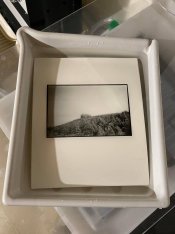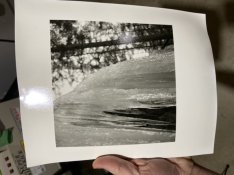NortheastPhotographic
Advertiser
I have my darkroom built out, my Analyser Pro calibrated, and a working solution of Ansco 130 has been sitting in my slot processor for about 2 months now. However I've been neglecting printing while I've been distracted by other things, so I wanted to pop in for a quick print tonight.
I went to Jay Peak last weekend for a much needed mini-vacation. The slopes were great and some lifelong friends joined us. I decided to try out the Harmon Reusable Camera for the trip. Simple enough for skiing and cheap enough that's it's hard to say no. I used one of the included rolls of Kentmere 400. I processed the film in my seasoned XTol. Frankly I thought the images are quite bad from my Fuji Frontier scans. It was almost like the film was not perfectly flat, which it may not have been since I had some trouble loading it. It's a very simple mechanism, and not all that well thought out.
Scans are scans and prints are prints though so I wanted to try it at 4x6 size. Viewing a Frontier scan on a 27" monitor is quite different from a 4x6 enlargement which is what disposable cameras were really meant to do.
I wanted to stick to the 'banish the test strip' moto from RH, so I just jumped right in.
Print 1: I placed the meter on the sun spot, a mistake. It's a very dense negative so with the sun as my highlight reading and a rock as my shadow it indicated grade 2, way too low.
Print 2: Damn it! I forgot to make my reading in 'focus' mode (using my Heiland LED cold light). The print is vastly over exposed. Interesting look though!
Print 3: Much better! I think I could now move to doing some dodging and burning. But now I'm tired and it's time to have a drink. (I started printing at 10pm).
It's a dense negative from a plastic lens, photographed inside a cloud... The contrast is low. I'm already at grade 5! When I take another crack at it I'll have to find a way to add a little snap. I may try split printing this or toning it after doing some dodge or burn work...
Really just 'thinking' like the Analyser Pro is the trick. I need to do better at placing my readings, and then understanding the dodge and burn modes. That zone scale is really handy. This particular negative only achieved a range about 2-3 light placements from the edges even on grade 5. I should have remembered to adjust exposure to get my true black, and then checking the time needed for my Zone VIII highlight for a dodge.
Also the tray life of Ansco 130 is amazing. When the 2L seems low I do top it off with about 3oz of working solution, so you can say it's getting replenished. Pretty slick!

I went to Jay Peak last weekend for a much needed mini-vacation. The slopes were great and some lifelong friends joined us. I decided to try out the Harmon Reusable Camera for the trip. Simple enough for skiing and cheap enough that's it's hard to say no. I used one of the included rolls of Kentmere 400. I processed the film in my seasoned XTol. Frankly I thought the images are quite bad from my Fuji Frontier scans. It was almost like the film was not perfectly flat, which it may not have been since I had some trouble loading it. It's a very simple mechanism, and not all that well thought out.
Scans are scans and prints are prints though so I wanted to try it at 4x6 size. Viewing a Frontier scan on a 27" monitor is quite different from a 4x6 enlargement which is what disposable cameras were really meant to do.
I wanted to stick to the 'banish the test strip' moto from RH, so I just jumped right in.
Print 1: I placed the meter on the sun spot, a mistake. It's a very dense negative so with the sun as my highlight reading and a rock as my shadow it indicated grade 2, way too low.
Print 2: Damn it! I forgot to make my reading in 'focus' mode (using my Heiland LED cold light). The print is vastly over exposed. Interesting look though!
Print 3: Much better! I think I could now move to doing some dodging and burning. But now I'm tired and it's time to have a drink. (I started printing at 10pm).
It's a dense negative from a plastic lens, photographed inside a cloud... The contrast is low. I'm already at grade 5! When I take another crack at it I'll have to find a way to add a little snap. I may try split printing this or toning it after doing some dodge or burn work...
Really just 'thinking' like the Analyser Pro is the trick. I need to do better at placing my readings, and then understanding the dodge and burn modes. That zone scale is really handy. This particular negative only achieved a range about 2-3 light placements from the edges even on grade 5. I should have remembered to adjust exposure to get my true black, and then checking the time needed for my Zone VIII highlight for a dodge.
Also the tray life of Ansco 130 is amazing. When the 2L seems low I do top it off with about 3oz of working solution, so you can say it's getting replenished. Pretty slick!













